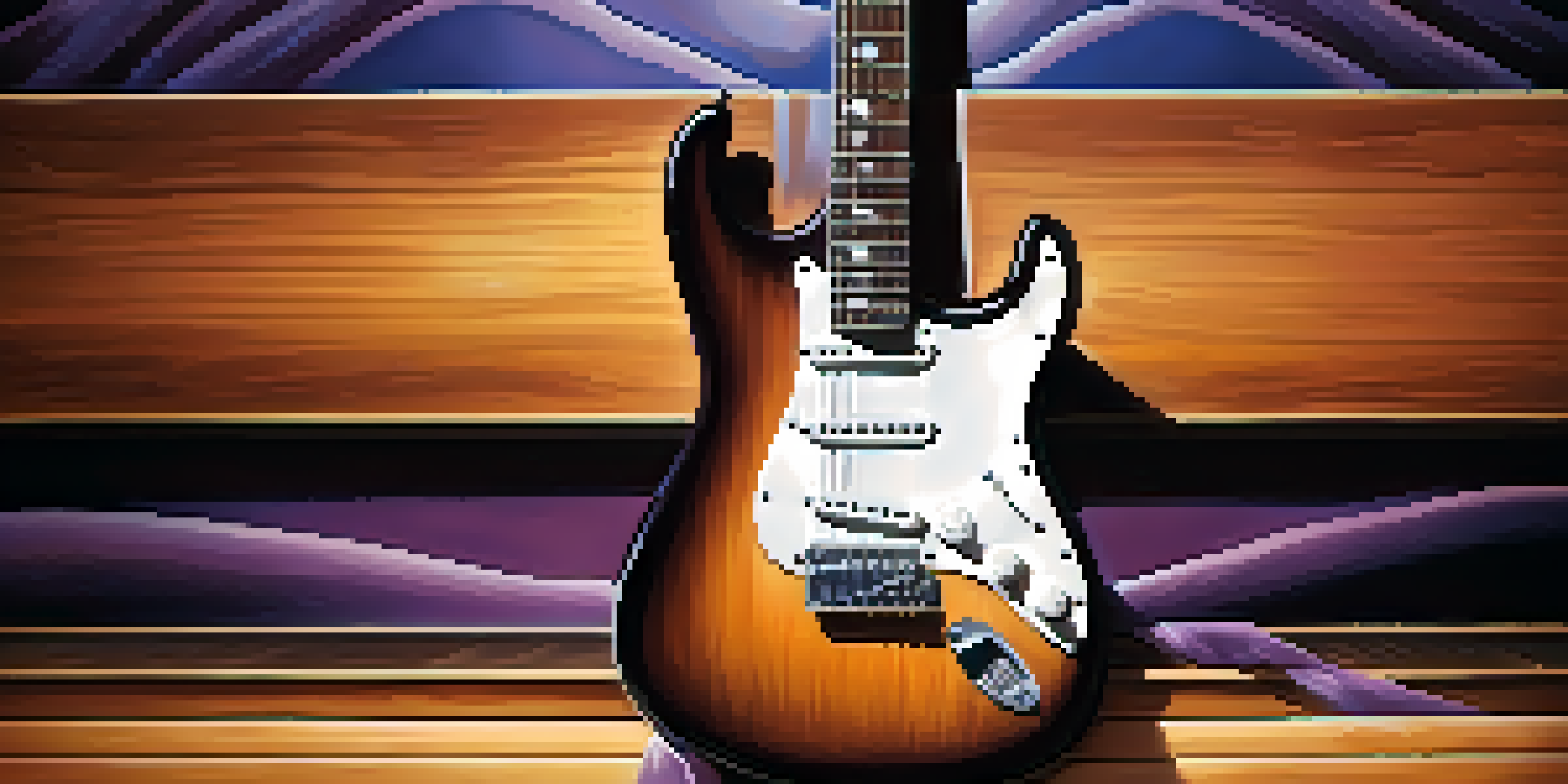Effects of Half-Step Down Tuning in Rock Music: A Deep Dive

What is Half-Step Down Tuning in Music?
Half-step down tuning is a popular guitar tuning where each string is tuned one semitone lower than standard tuning. This technique alters the pitch of the notes played, creating a darker and heavier sound that many rock musicians love. It's often used to achieve a moodier atmosphere in songs, which can enhance the emotional impact of the music.
Music is the shorthand of emotion.
For example, if a standard E string is tuned down to E flat, the overall tonal quality shifts, providing a different resonance. This tuning method can also make it easier for vocalists to hit lower notes without straining, which is especially beneficial in rock music where powerful vocals are key. Ultimately, it opens up new creative possibilities for both guitarists and singers.
Half-step down tuning has become synonymous with various rock subgenres, from grunge to metal, as it establishes a unique sound that sets these styles apart. Many iconic bands, like Alice in Chains and Metallica, have incorporated this tuning technique, helping to solidify its place in rock music history.
Historical Context and Popularity of Half-Step Down Tuning
The use of half-step down tuning can be traced back to the late 1960s and early 1970s when rock musicians began experimenting with different tunings to create unique sounds. This era marked a significant shift in rock music, as artists sought to break away from traditional structures and explore new musical landscapes. Bands like Black Sabbath and Led Zeppelin were pioneers in this approach, influencing countless musicians.

As rock evolved through the decades, so did the popularity of down-tuning. The grunge movement of the 1990s, for instance, embraced half-step down tuning as a way to express raw emotion and angst, with bands like Nirvana and Soundgarden leading the way. Their heavy, distorted sounds paired with this tuning created a signature style that resonated with a generation.
Half-Step Down Tuning Explained
This tuning lowers each guitar string by one semitone, creating a darker tone that enhances emotional depth in rock music.
Today, half-step down tuning remains a staple in rock music, embraced by both classic and contemporary artists. Its rich history and ongoing influence show just how effective a simple tuning change can be in shaping the sound of an entire genre.
Effects on Guitar Sound and Tone
One of the most immediate effects of half-step down tuning is the change in guitar tone. When strings are tuned lower, the guitar produces a fuller, more resonant sound that can add depth to riffs and solos. This rich tone is often characterized by a warmer, heavier feel, which many rock guitarists strive for to create a powerful auditory experience.
The only truth is music.
Moreover, this tuning can enhance the way distortion interacts with the guitar. When you apply distortion to a half-step down-tuned guitar, the resulting tone can be thicker and more aggressive, which is particularly appealing in genres like metal and hard rock. This combination allows musicians to create soundscapes that are both complex and dynamic.
Additionally, down-tuning can lead to a change in string tension, which affects how the guitar feels to play. Lower tension can make bending notes easier, allowing for expressive solos and emotive playing. This is a significant advantage for guitarists looking to push their musical boundaries and explore new artistic directions.
Influence on Songwriting and Composition
Half-step down tuning can have a profound impact on songwriting and composition, as it inspires musicians to think outside the box. The different tonal qualities and resonance can lead to new chord progressions and melodies that might not emerge in standard tuning. This exploration often results in more innovative and unique songs that stand out in the rock genre.
For example, many songwriters find that certain chord shapes resonate differently when played in half-step down tuning, leading to fresh harmonic ideas. This can be especially useful when crafting ballads or heavier tracks, where the emotional weight of the music is crucial. It allows artists to tap into a deeper emotional well, ultimately enhancing their songwriting process.
Influence on Songwriting
Half-step down tuning inspires unique chord progressions and melodies, leading to innovative and emotionally resonant songs.
Moreover, the tonal shifts can also influence lyrical themes and vocal delivery. With the music feeling darker or heavier, artists might feel compelled to write lyrics that reflect these changes, resulting in a cohesive artistic vision. This interplay between tuning and songwriting is a powerful tool for any musician looking to elevate their craft.
Vocal Considerations and Effects
Vocalists also benefit from half-step down tuning, as it allows for more comfortable singing ranges. By lowering the pitch of the instruments, singers can find their sweet spot without straining their voices. This is particularly valuable in rock music, where powerful and emotive vocal performances are essential to connect with the audience.
Artists like Chris Cornell and Eddie Vedder have famously utilized half-step down tuning to navigate their lower vocal registers while maintaining their signature intensity. The ability to hit low notes with ease can lead to more dynamic performances, engaging listeners in a way that's both thrilling and authentic.
Additionally, this tuning can help create a more cohesive sound between the instruments and vocals. As the guitar and vocals resonate at similar frequencies, the overall mix can feel more unified. This harmony enhances the listener's experience, making it easier to immerse themselves in the music.
Iconic Songs That Use Half-Step Down Tuning
Many iconic rock songs prominently feature half-step down tuning, showcasing its versatility and impact. For instance, 'Black Hole Sun' by Soundgarden exemplifies how this tuning can create a haunting atmosphere while maintaining catchy melodies. The combination of dark lyrics and rich guitar tones makes it a classic that resonates with listeners.
Another notable example is 'Man in the Box' by Alice in Chains, where the distinctive sound of the down-tuned guitar complements the raw, emotive vocals. This song highlights how half-step down tuning can elevate both the musical and lyrical elements, creating a powerful listening experience.
Future of Tuning in Rock
As music evolves, half-step down tuning continues to play a vital role, allowing artists to push creative boundaries in modern rock.
These songs, among many others, demonstrate that half-step down tuning is not just a technical choice but a creative tool that can shape the identity of a track. As artists continue to explore this tuning, it will undoubtedly lead to more memorable and impactful music.
The Future of Half-Step Down Tuning in Rock Music
As music evolves, so does the application of half-step down tuning. Contemporary artists continue to experiment with this technique, integrating it into various subgenres and pushing the boundaries of sound. With the rise of genres like post-rock and alternative metal, down-tuning remains a relevant and exciting aspect of modern rock music.
Moreover, advances in technology and production techniques allow musicians to manipulate sound in ways previously unimaginable. This means that half-step down tuning can be combined with effects, layering, and other elements to create unique sonic experiences. The possibilities are endless, and artists are likely to keep finding innovative ways to incorporate this tuning into their work.

Ultimately, half-step down tuning is more than just a stylistic choice; it's a vital part of rock music's evolution. As musicians embrace its versatility and potential, we can expect to see this tuning continue to play a significant role in shaping the future of the genre.